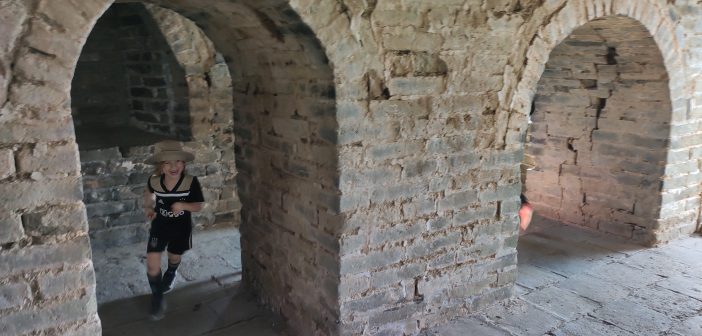When my first child was six months old, we visited an impressive art exhibition on Pompei. One grandpa in front of us in line tsk-tsked us and said, “He won’t remember it.” My husband saw me boiling with anger over such blatant disrespect for treating children as human beings and politely said, “Maybe not, but it will sure make an impression.”
Even as they grow older, it’s hard to know what kids will “get” from historical landmarks. Rather than dictate how their experience should be, we mostly want our kids to see how large the world really is, and how much history we can find just outside our door here. In order for this to happen, we must create an environment where our kids can enjoy our trips on their terms as well as our more adult ones.
It’s easy to get them burnt out on sightseeing if you don’t approach it right and let them lead once in a while. Children have very little control over their lives when they’re young. Whether it’s a guided or self-tour, there are a few ways to help your kids enjoy the time and stay involved in your explorations without inviting frustrating meltdowns.
Let Them Help You Plan
Many places have videos and maps online that you can view. A lot of Beijing’s landmarks also have accompanying children’s books to get them excited. A Wikipedia entry might not be the most enchanting place to start for a five-year-old, but give them a cool illustrated map of The Great Wall and they’ll just want to know “How soon?”

We love books about The Great Wall
Let Them Enjoy It However They Want (Within Reason)
It’s hard to know how a three and five-year-old will react to a ski lift up to The Great Wall, then kilometers and kilometers of walking before turning around and doing it all over again. Of course, they loved the toboggan down, but that was at the end.
So when they want to count each and every step and you just need to catch your breath, you keep counting with them. When they don’t want to see the view but want to play their new game called “The Terrible Maze,” you become the monster who traps them. When some of the most incredible pieces of history stand before you and they are entranced by that one loose tile on the floor, you let them balance and wiggle on it as long as they need. There’s no point in trying to force an appreciation of history. You’ll have longer-lasting success if their memories involve having fun, their way.
Honor Their Wishes If They Need a Break
It’s hard to walk through museums. History as ancient as China takes a lot of brainpower to comprehend, and even adults have trouble with it. Children have fewer touchpoints when it comes to the context of what they’re seeing, and the longer the outing, the harder it is for them. This is not for lack of interest or curiosity; they really just need a break.
When you sense they are overwhelmed, the worst thing to do is power through the outing. Maybe they just need a minute to sit and not think about anything. Maybe they just need food. Maybe they need fresh air. Or they may simply need to know that their discomfort is being heard and accepted. When they say they’re done, or keep asking when it’s over, parents sometimes hold the line that it’s almost over, or insist the kids can hold on just a few more minutes. In reality, they have been holding onto their wits, and now they’re at a breaking point.
So let them sit on the steps with you a minute and process everything. History is a lot for a developing mind to grasp. Allowing time for their mind to settle will gain you more quality time than ignoring their feelings until they meltdown. I might be talking from direct experience here.

Give your kids the time they need to rest their bodies and brains
Spend the Extra for a Private Guide Versus a Large Group
It’s harder to ask a bus full of people to stop so your child can use the bathroom. A private guide may be more willing to adjust a route for necessary breaks. This is another situation where rushing them will only make it worse and not allow anyone the time necessary to take care of their personal business. Additionally, it’s much harder to “aim” into an empty coffee cup on a moving bus than you might think. And yes, I am absolutely talking from personal experience here.
Pack Plenty of Snacks. No, More Than That
Half the issues kids have on outings is because they need food. They burn a lot of energy that must be replenished. You know that term “hangry,” when you get mad and unreasonable because you need to eat? Triple your typical rations for an outing! We will bring one box of granola bars per person per six hours, minimum. Then a healthy amount of fresh fruit and some treats when they need an extra perk.

A good selection of tastes will keep everyone on their toes
Go as Plastic-Free as Possible
Being out in a landmark is an especially good place to get your kids involved in sustainability and loving the earth. Use the together time to make an effort towards reducing your plastic use for the greater good. Pack all food in reusable packaging, separate your trash into recyclables, food waste, and non-recyclables, avoid plastic water bottles whenever possible, and tell them exactly why you’re doing this. Yes, it means that your backpacks will turn into trash bags by the second half of the trip, but they can be washed. The earth cannot.
Give Them Ownership of Their Memories
My oldest loves to vlog our trips and my youngest loves to take pictures. They have their own small cameras to do so, and I love watching them start to understand how to tell stories through pictures. We know enough about photography and videography to give them a nudge towards better storytelling, and they often want to learn more through online tutorials later. Sometimes how they see the trip is illuminated by the photos they share. Bonus points: I guarantee your kids will learn to take flattering photos of you too!
KEEP READING: Golden Week at Home: Day Trips You Always Wanted to Try but Never Had Time
Photos: Canva, Cindy Marie Jenkins




